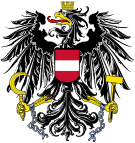1956 Austrian legislative election
First party
Second party
Leader
Julius Raab
Adolf Schärf
Party
ÖVP
SPÖ
Last election
41.26%, 74 seats
42.11%, 73 seats
Seats won
82
74
Seat change
Popular vote
1,999,986
1,873,295
Percentage
45.96%
43.05%
Swing
pp
pp
Third party
Fourth party
Leader
Anton Reinthaller
Johann Koplenig
Party
FPÖ
KPÖ
Last election
–
5.28%, 4 seats,
Seats won
6
3
Seat change
New
Popular vote
283,749
192,438
Percentage
6.52%
4.42%
Swing
New
pp
Results by constituency
Parliamentary elections were held in Austria on 13 May 1956.[ 1] Austrian People's Party , which won 82 of the 165 seats in the National Council . Voter turnout was 96%.[ 2] Chancellor Julius Raab retained the grand coalition with the Socialists , with the SPÖ leader Adolf Schärf as Vice-Chancellor .
Results Party Votes % Seats +/– Austrian People's Party 1,999,986 45.96 82 +8 Socialist Party of Austria 1,873,295 43.05 74 +1 Freedom Party of Austria 283,749 6.52 6 –8 Communists and Left Socialists 192,438 4.42 3 –1 Free Workers Movement of Austria 1,812 0.04 0 New Party of Reason 284 0.01 0 New Ergokratische Party 231 0.01 0 New Austrian Patriotic Party 83 0.00 0 0 Austrian Middle Class Party 23 0.00 0 New Parliamentary Representatives of the People prevented from voting, Non-Voters and Invalid Voters 7 0.00 0 New Total 4,351,908 100.00 165 0 Valid votes 4,351,908 98.29 Invalid/blank votes 75,803 1.71 Total votes 4,427,711 100.00 Registered voters/turnout 4,614,464 95.95 Source: Nohlen & Stöver
Results by state
References
^ Dieter Nohlen & Philip Stöver (2010) Elections in Europe: A data handbook , p196 ISBN 978-3-8329-5609-7^ Nohlen & Stöver, p214
^ "National election results Austria 1919 - 2017 (OA edition)", Institute for Social Research and Consulting (SORA) (in German), Austrian Social Science Data Archive (AUSSDA), 2019-07-24, doi :10.11587/EQUDAL









